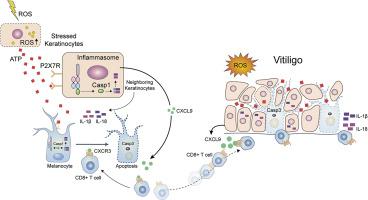Journal of Investigative Dermatology ( IF 5.7 ) Pub Date : 2020-02-06 , DOI: 10.1016/j.jid.2019.12.035 Yuri Ahn 1 , Jimyung Seo 2 , Eun Jung Lee 3 , Ji Young Kim 1 , Min-Young Park 1 , Shinwon Hwang 1 , Abdurrahman Almurayshid 4 , Beom Jin Lim 5 , Je-Wook Yu 6 , Sang Ho Oh 3

|
Extracellular adenosine 5ʹ-triphosphate (ATP) is a well-known inflammasome-activating signal. Emerging evidence demonstrates a critical role for inflammasome activation in vitiligo pathogenesis. However, the specific molecular mechanism of inflammasome-dependent melanocyte degeneration in vitiligo is still not clear. This study presents how extracellular ATP, released from keratinocytes by oxidative stress, affects melanocyte survival in vitiligo skin. H2O2-induced oxidative injury increased ATP release from keratinocytes and skin tissues. The high concentration of extracellular ATP induced both ROS production and cell death in melanocytes. Treatment with ATP caused the activation of caspase-1 as well as the production of active forms of IL-1β and IL-18 via P2X7 receptor in keratinocytes and melanocytes. Lesional and perilesional skin of vitiligo showed higher levels of ATP as well as upregulation of active caspase-1 compared with nonlesional skin, suggesting its possible role in inflammasome activation in vitiligo. Moreover, the elevated expression of CXCL9 in keratinocytes, mediated through ATP/P2X7 receptor–dependent inflammasome activation, was responsible for CLA+CD8+ T-cell chemotaxis into the skin. These results demonstrate that extracellular ATP as a danger signal activates the inflammasome pathway and increases cutaneous chemotaxis of CD8+ T cells via CXCL9 in vitiligo. Therefore, targeting ATP-P2X7 signaling may be a potential strategy for vitiligo treatment.
中文翻译:

ATP-P2X7诱导的炎症小体激活导致白癜风中黑素细胞死亡和CD8 + T细胞向皮肤的运输。
细胞外腺苷5′-三磷酸(ATP)是众所周知的炎症小体激活信号。越来越多的证据表明炎性体激活在白癜风发病中起着至关重要的作用。但是,白癜风中炎性体依赖性黑素细胞变性的具体分子机制仍不清楚。这项研究提出了氧化应激从角质形成细胞释放的细胞外ATP如何影响白癜风皮肤中黑素细胞的存活。H 2 O 2诱导的氧化损伤增加了角质形成细胞和皮肤组织中ATP的释放。高浓度的细胞外ATP诱导黑素细胞中ROS的产生和细胞死亡。ATP处理可导致Caspase-1活化,并通过角质形成细胞和黑素细胞中的P2X7受体产生活性形式的IL-1β和IL-18。与非病灶皮肤相比,白癜风的病灶和病灶周围皮肤显示出更高的ATP水平以及活性caspase-1的上调,表明其可能在白癜风的炎症小体活化中发挥作用。此外,通过ATP / P2X7受体依赖性炎症小体激活介导的角质形成细胞中CXCL9的表达升高是CLA + CD8 +的原因。T细胞趋化性进入皮肤。这些结果表明,作为危险信号的细胞外ATP通过白癜风中的CXCL9激活炎性体途径并增加CD8 + T细胞的皮肤趋化性。因此,靶向ATP-P2X7信号可能是白癜风治疗的潜在策略。











































 京公网安备 11010802027423号
京公网安备 11010802027423号